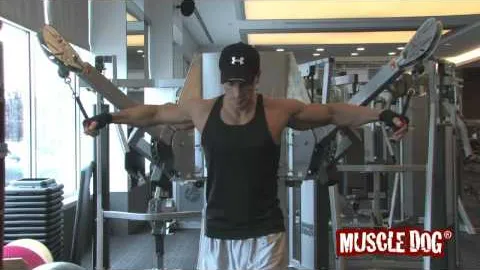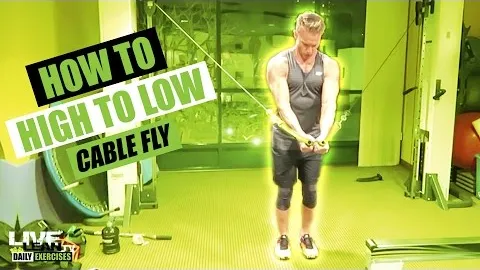

Cable Fly High to Low: A Comprehensive Guide for Effective Chest Development
If you're looking to enhance your chest muscles and achieve that well-defined, chiseled look, incorporating the Cable Fly High to Low exercise into your workout routine can yield impressive results. This movement specifically targets the pectoralis major muscles along with the deltoids, making it an excellent choice for a well-rounded upper body workout. In this guide, we will delve into the proper execution of the Cable Fly High to Low exercise, its benefits, and how to incorporate it effectively into your fitness regimen.
To perform the Cable Fly High to Low exercise, follow these simple steps:
Setup: Start by setting the cable pulleys to the highest position. Attach the D-handles to each cable, ensuring they are at the same height. Stand midway between the two cable stacks, keeping your feet shoulder-width apart and maintaining a slight bend in your knees.
Grip and Stance: Grasp the D-handles with an overhand grip, ensuring your palms face downward. Keep your elbows slightly bent and in line with your shoulders throughout the exercise. Position yourself with a slight forward lean, engaging your core for stability.
Movement: Begin the exercise by pulling the D-handles down towards your sides while maintaining an arc-like motion. Aim to bring your hands together in front of your torso, squeezing your chest muscles as you do so. Keep your elbows slightly bent throughout the movement.
Full Range of Motion: Lower the cables as far down as possible without compromising your form or straining your shoulders. Feel the stretch in your chest muscles during this downward motion. Once you reach your maximum range of motion, reverse the movement and bring your hands back to the starting position, ensuring a controlled and deliberate pace.
Repeat and Sets: Aim for 8-12 repetitions per set, and perform 3-4 sets with appropriate rest intervals between each set. As you become more proficient, you can progressively increase the weights for greater intensity.
Muscle Isolation: The Cable Fly High to Low exercise effectively isolates the pectoralis major muscles, allowing for targeted development and improved muscle definition in the chest area.
Deltoid Engagement: In addition to targeting the chest muscles, this exercise also engages the deltoids, helping to build well-rounded shoulder development and upper body strength.
Range of Motion: The movement pattern involved in the Cable Fly High to Low exercise allows for an extended range of motion compared to other chest exercises, effectively increasing muscle activation for enhanced development.
Variation and Adaptability: This exercise can be modified to suit various fitness levels by adjusting the weight or changing the angle of the cable pulleys. It can also be performed using different handle attachments, providing versatility for targeting specific muscle groups within the chest.
Core Stability: The Cable Fly High to Low exercise requires engaging your core muscles throughout the movement, promoting stability, balance, and overall functional strength.
Injury Prevention: By working through a controlled range of motion and maintaining proper form, the Cable Fly High to Low exercise can help strengthen the muscles surrounding the shoulder joint, reducing the risk of injury during other upper body exercises.
To maximize the benefits of the Cable Fly High to Low exercise, consider the following suggestions when incorporating it into your workout routine:
Warm-Up: Prioritize a thorough warm-up to prepare your chest and shoulder muscles for the exercise. Dynamic stretches, such as arm circles and chest opener stretches, can help loosen up the muscles and reduce the risk of injury.
Exercise Order: Place the Cable Fly High to Low exercise early in your workout routine, after compound exercises like bench press or push-ups. This ensures that you have ample strength and energy to perform the exercise optimally.
Sets and Repetitions: Aim for 3-4 sets of 8-12 repetitions, adjusting the weight accordingly to challenge your muscles without sacrificing proper form.
Progressive Overload: To continue improving and challenging your muscles, gradually increase the weight lifted over time. This progressive overload principle stimulates muscle growth and strength gains.
Superset or Compound Movements: Pair the Cable Fly High to Low exercise with other compound movements like push-ups or military press to further enhance your upper body workout.
Rest and Recovery: Allow adequate rest intervals between sets to ensure proper muscle recovery, usually around 60 seconds. This allows your muscles to recuperate and maintain consistent performance throughout your workout.
Fitness Professional Assistance: When starting a new exercise program or if you're unsure about proper form, it's advisable to seek guidance from a fitness professional to avoid any potential injuries and receive personalized advice.
The Cable Fly High to Low exercise is a valuable addition to any workout routine, offering numerous benefits for chest development and upper body strength. By implementing this exercise correctly and progressively challenging yourself, you can transform your chest muscles and achieve the well-defined physique you desire. Remember to prioritize proper form, gradually increase the weight lifted, and seek professional guidance, if needed, to maximize results while minimizing the risk of injury. Incorporate the Cable Fly High to Low exercise into your fitness regimen today, and experience the incredible benefits it has to offer.
If you're looking for a gym, fitness club or yoga studio, you've come to the right place.
You can find information about gyms in your area. Browse catalog of gyms and find gyms with classes which are you looking for.
On gym page you can find simple information like address, phone or website. You can find list of available classes. You can check availability of personal training or small group classes. On place page you can also see information about open hours.
You can find gyms near you with amenities, courts, studios and equipments.
Use our map to find gym at your city or district.
In Gym Navigator you can find list of exercises with movies for many body parts.
You can browse exercises catalog and find exercises the best of you.
You can also find exercises grouped into workout plans, which you can use to improve you body. Each routine show you exercises one by one and give you possibility to count you progress and count down rest time.